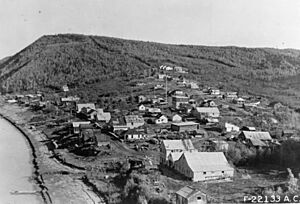Ruby, Alaska facts for kids
Quick facts for kids
Ruby
Tl'aa'ologhe
|
|
|---|---|

Ruby in the 1940s
|
|
| Nickname(s):
The Gem of the Yukon
|
|
| Country | United States |
| State | Alaska |
| Census Area | Yukon-Koyukuk |
| Incorporated | September 25, 1973 |
| Area | |
| • Total | 7.03 sq mi (18.19 km2) |
| • Land | 7.03 sq mi (18.19 km2) |
| • Water | 0.00 sq mi (0.00 km2) |
| Elevation | 249 ft (76 m) |
| Population
(2020)
|
|
| • Total | 139 |
| • Density | 19.79/sq mi (7.64/km2) |
| Time zone | UTC-9 (Alaska (AKST)) |
| • Summer (DST) | UTC-8 (AKDT) |
| ZIP code |
99768
|
| Area code | 907 |
| FIPS code | 02-65590 |
| GNIS feature ID | 1408878 |
Ruby is a small town in central western Alaska. Its name in the Koyukon language is Tl'aa'ologhe. Ruby is located on the south bank of the Yukon River, near the Nowitna National Wildlife Refuge.
You can only reach Ruby by boat or by plane. The town used to be a busy place for gold mining and lumber. In 2010, only 166 people lived there. Today, Ruby has a general store and a post office. The town is served by Ruby Airport.
Contents
History of Ruby
Ruby became a town in 1911 because of a gold rush. A gold rush is when many people quickly move to an area where gold has been found. The first gold in Ruby was found in 1906 on Ruby Creek. This discovery brought more gold seekers to the area.
When was gold first found in Ruby?
In 1910, news spread about a big gold discovery on Long Creek. This creek is about 30 miles south of Ruby. Many people rushed to the area, hoping to find gold. More gold was found on other nearby creeks. Ruby then became the main place to get supplies for the mines.
What happened to Ruby after the gold rush?
At its busiest, Ruby had nearly 3,000 people. But by 1918, the town started to shrink. Many men left to fight in World War I. Also, some business owners and their families were lost when the ship Sophia sank.
A big fire in 1929 destroyed many businesses in Ruby. Then, a flood in 1931 washed away the remaining buildings along the river. After World War II, Native Americans from a nearby area called Kokrines moved to Ruby. They used the empty homes that were left behind. Today, fewer than 200 people live in Ruby.
What is the biggest gold nugget found in Alaska?
The largest gold nugget ever found in Alaska was discovered near Ruby in 1998. It weighed about 294 troy ounces, which is over 20 pounds!
Geography of Ruby
Ruby is located in a remote part of Alaska. The city covers an area of about 7.6 square miles (19.7 square kilometers). All of this area is land, with no water.
Population of Ruby
| Historical population | |||
|---|---|---|---|
| Census | Pop. | %± | |
| 1920 | 128 | — | |
| 1930 | 132 | 3.1% | |
| 1940 | 138 | 4.5% | |
| 1950 | 132 | −4.3% | |
| 1960 | 179 | 35.6% | |
| 1970 | 145 | −19.0% | |
| 1980 | 197 | 35.9% | |
| 1990 | 170 | −13.7% | |
| 2000 | 188 | 10.6% | |
| 2010 | 166 | −11.7% | |
| 2020 | 139 | −16.3% | |
| U.S. Decennial Census | |||
Ruby first appeared in the U.S. Census in 1920. It was officially made a city in 1973.
Who lives in Ruby?
According to the 2000 census, there were 188 people living in Ruby. Most of the people were Native American, making up about 83% of the population. About 14% were White.
Many households in Ruby had children under 18 living with them. The average age of people in Ruby was 33 years old.
Education in Ruby
The Yukon–Koyukuk School District runs the Merreline A. Kangas School in Ruby. This school helps educate the children in the community.
Famous People from Ruby
- Barry Clay (born 1955): He found Alaska's largest gold nugget near Ruby in 1998.
- Emmitt Peters (1940–2020): He was the last new racer to win the Iditarod Trail Sled Dog Race in 1975.
Images for kids
See also
 In Spanish: Ruby (Alaska) para niños
In Spanish: Ruby (Alaska) para niños






